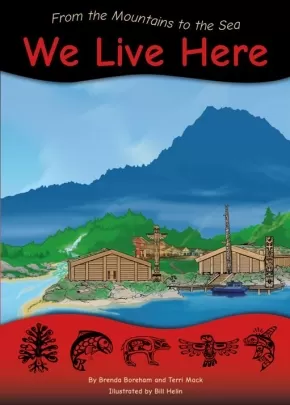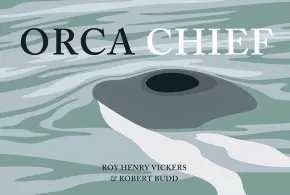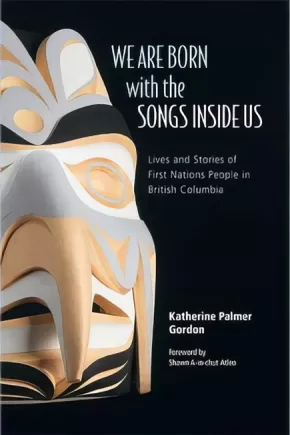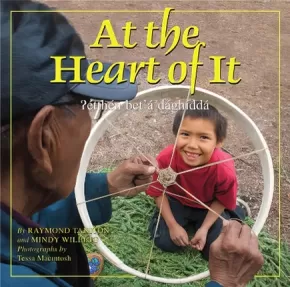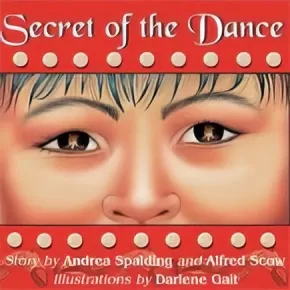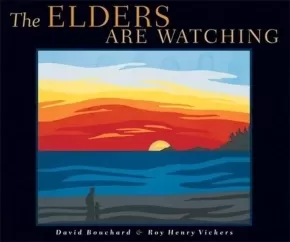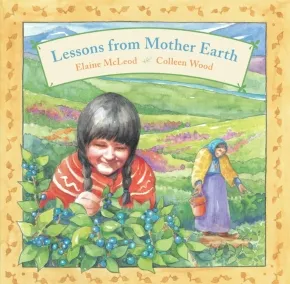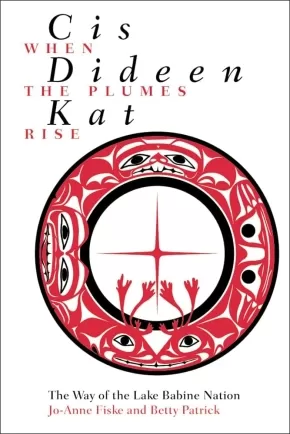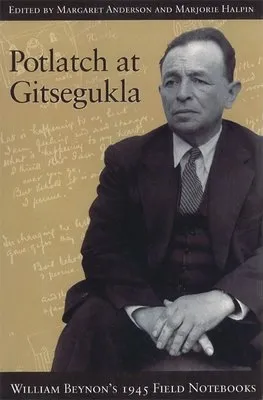
BC First Nations Land, Title, and Governance: Elementary / Secondary (Grades 2 - 12)
16
-
26
of
26 Results;
Sort By
Go To
of 2
From the Mountains to the Sea: We Live Here
 $29.95
$29.95

Artists:
Format:
Paperback
Text Content Territories:
Indigenous Canadian;
Grade Levels: Kindergarten;
ISBN / Barcode: 9781771741019
Synopsis:
Synopsis:
Each book in the series, From the Mountains to the Sea, supports the new BC Aboriginal Learning Standards in both Science and Social Studies.
From the Mountains to the Sea: We Live Here is a Kindergarten resource, which covers all of your Aboriginal Learning Standards in both science and social studies within the new BC curriculum.
Click link to download a five-week Kindergarten planning guide: Kindergarten FREE Download for We Live Here
Back of book introduction:
This book is about a river. Can you find a river on the front cover of this book? What do you know about rivers?
Most rivers start high up in the mountains. As the water comes down the hill, it makes little pathways in the rocks and gravel. As the pathways get bigger, they join to make streams. Sometimes the streams join together to make a river. Where a river leaves the mountains the ground flattens out, and the river slows down. The river ends when it flows into the sea.
The area in and around a river is a good place for plants, animals and people to live because we can all find food and water there. The salmon is an important food for many of us.
Some of the plants and animals that you will find in this book are:
- Cedar trees live and grow all the way along a river, from the mountains to the sea.
- Salmon spend their adult lives out in the open sea. When it is time to lay their eggs, they swim back to their home streams. Their home streams are sometimes very close to the mountains.
- Bears walk long distances to find their food. They live from the mountains to the sea. In the fall they go to the rivers to fish for salmon.
- Eagles fly over large areas looking for food. They live from the mountains to the sea. In the fall, they go to the rivers to feast on salmon.
- Orcas live in the open sea. They swim long distances to hunt for food. Some orcas eat salmon.
This book is also part of a bundled package: From the Mountains to the Sea: We Live Here Bundle
This resource is available in French: Collection Des montagnes à la mer: Nous habitons ici
Additional Information
Book dimensions: 10" x 14" | Pages: 16 | ISBN: 9781771741019
Orca Chief
$19.95
Format:
Hardcover
Text Content Territories:
Indigenous Canadian; First Nations; Tsimshian (Ts'msysen);
ISBN / Barcode: 9781550176933
Synopsis:
Synopsis:
Thousands of years ago in the village of Kitkatla, four hunters leave home in the spring to harvest seaweed and sockeye. When they arrive at their fishing grounds, exhaustion makes them lazy and they throw their anchor overboard without care for the damage it might do to marine life or the sea floor.
When Orca Chief discovers what the hunters have done, he sends his most powerful orca warriors to bring the men and their boat to his house. The men beg forgiveness for their ignorance and lack of respect, and Orca Chief compassionately sends them out with his pod to show them how to sustainably harvest the ocean’s resources.
Accompanied by almost exclusively new illustrations by Roy Henry Vickers, this next installment of the Northwest Coast Legends will captivate readers young and old with its vivid imagery and remarkable storytelling.
Educator & Series Information
Orca Chief is the third in a series of Northwest Coast legends by Roy Henry Vickers and Robert Budd.
Other books in this series include:
Raven Brings the Light
Cloudwalker
Orca Chief
Peace Dancer
Recommended for ages 3 to 6.
Additional Information
40 pages | 12.00" x 8.25"
Written as I Remember It: Teachings from the Life of a Sliammon Elder
$39.95
Format:
Paperback
Text Content Territories:
Indigenous Canadian; First Nations; Salish; Coast Salish; Tla'amin (Sliammon);
ISBN / Barcode: 9780774827119
Synopsis:
Synopsis:
Long before vacationers discovered British Columbia's Sunshine Coast, the Sliammon, a Coast Salish people, called the region home. Elsie Paul is one of the last surviving mother-tongue speakers of the Sliammon language. In this remarkable book, she collaborates with her granddaughter, Harmony Johnson, and a scholar, Paige Raibmon, to tell her life story and the history of her people, in her own words and storytelling style. Raised by her grandparents who took her on their seasonal travels, Paul spent most of her childhood learning Sliammon ways, teachings, and stories. She shares this traditional knowledge with future generations in Written as I Remember It.
Educator Information
Recommended in the Canadian Indigenous Books for Schools 2019-2020 resource list as being useful for grades K-12 for the following subject areas: English Language Arts, Science, Social Studies, Teacher Resource.
Strong Readers Set B: Planning the Feast (L17)
 $9.00
$9.00

Artists:
Format:
Paperback
Grade Levels: 2;
ISBN / Barcode: 9781771740388
Synopsis:
Synopsis:
Level 17 Illustrated by Bill Helin. Back cover book introduction: Soon there will be a big summer feast at Pine Forest. Raven is ready with lots of plans. What are some of the things that might need to be done before the summer feast? Do you predict Raven will be a good planner?
Educator & Series Information
Planning the Feast is part of the Strong Readers: Set B series. Set B is a continuation of Set A. The mixture of fiction and non-fiction books, from levels 11 through 20, expands on frog, bear, eagle, and raven, considering their full lifecycles.
The Strong Readers are a guided/leveled reading series chock full of science, numeracy, social responsibility, language arts and oral language teachings. Strong Readers are rich with scaffolded text features and have beautiful illustrations and photographs. The entire series is interconnected and follows the cultural values of frog, bear, eagle and raven throughout.
Guided Reading Level: 17
This resource is also available in French: Planifier le festin.
Additional Information
Book Dimensions: 6in x 9in | Pages: 16 | ISBN: 9781771740388
We Are Born with the Songs Inside Us: Lives and Stories of First Nations People in British Columbia
$29.95
Format:
Paperback
Text Content Territories:
Indigenous Canadian; First Nations;
ISBN / Barcode: 9781550176186
Synopsis:
Synopsis:
First Nations are the fastest growing population in the country. There are thousands upon thousands of young First Nations people growing up today who, together with the kind of individuals whose stories are told in this book, represent a future for this country that is brighter than it has been for a long, long time.--from the foreword by Shawn A-in-chut Atleo, National Chief of the Assembly of First Nations
Since 2004, journalist Katherine Palmer Gordon has interviewed dozens of young First Nations people living in British Columbia--artists and community leaders, comedians and consultants, musicians and lawyers, people who are household names and those known only within their own communities. We Are Born with the Songs Inside Us collects sixteen candid stories gleaned from those interviews, stories of people who share an unshakeable belief in the importance of their cultural heritage to their well-being, to their success at what they do, and to their everyday lives.
Included are Kim Baird, former chief of the Tsawwassen First Nation; Lisa Webster-Gibson, spoken word artist and rock-and-roll drummer with Delaware-Mohawk and Scottish-Canadian heritage who lives and works on Gabriola Island as an Environmental Assessment Professional; and John Marston (Qap'u'luq), an artist and storyteller from the Chemainus First Nation who learned to carve from his father. "What I put into each piece," he says, in his interview with Gordon, "is 100 percent me."
Shattering stereotypes, We Are Born with the Songs Inside Us gathers the thoughts and hopes of young native people living in twenty-first century Canada. Each has a compelling, meaningful story that deserves to be told, understood and, above all, celebrated.
Authenticity Note: The author of this book is not Indigenous; however, those who contributed the stories for the book are Indigenous. It is up to readers to determine if this will work as an authentic text for their purposes.
At the Heart of It: Dene dzó t’áré
$19.95
Format:
Hardcover
Text Content Territories:
Indigenous Canadian; First Nations; Dene; North Slavey (Sahtu);
ISBN / Barcode: 9781897252697
Synopsis:
Synopsis:
Raymond Taniton is Sahtugot'ine, which means "people from the Sahtu or Great Bear Lake." He lives in Deline, Northwest Territories, on the shore of Sahtu, Canada's largest and most pristine lake. Raymond, former chief, is one of his community's many gifted leaders.
In At the Heart of It, the seventh book in The Land is Our Storybook series, Raymond shows readers how to make a traditional Dene drum with the help of his father, Alfred, who is a leader and the "keeper of the drum." Raymond shares the importance of keeping traditions alive to maintaining a healthy community. He also introduces readers to Dene spiritual, political, and traditional leaders and explains why Deline is a leader in the NWT in terms of healthy places, people, and land. Sahtugot'ine have never given up their right and responsibility to look after and govern themselves. Join Raymond and find out what is at the heart of the rich history of the Sahtugot'ine.
Educator & Series Information
This book is part of the "The Land Is Our Storybook" series, which considers the diverse lands and cultures of Canada's Northwest Territories. Told in a uniquely diverse range of northern voices, with a child-centred approach, books in the series highlight each official Aboriginal language group in the NWT, revealing a richly textured picture of life in the North-on the trapline, around the campfire, in communities, at school, and within the outdoor school that is the land itself. The series celebrates the seasons, ages, genders, traditional activities, and communities of the NWT.
The stories are illustrated by the striking images of acclaimed northern photographer, Tessa Macintosh and depict the similarities in lifestyle between children of the North and South, as well as the marked cultural differences, and highlight the special relationship these First Nations people have with the land and how they are adapting to rapid change while remaining connected to the land. Images of the landscape and animals within it, of trapping, hunting, fishing, and bannock baking sit alongside pictures of children at school, swimming at recreation centres, and reading in libraries. Here is modern northern culture painted beautifully: a complex mix of the new and the old.
These wonderful books, written with a variety of provincial and territorial curricula in mind, are specially designed for the classroom and include special features such as glossaries relating details on animals biology and cultural definitions, regional and language maps. The text of the stories also have sidebars such as Our Stories, which contain the stories of the people and language group featured, and Our Words, which highlight words in the featured language that are important to the story.
Additional Information
|
Secret of the Dance
$12.95
Artists:
Format:
Paperback
Text Content Territories:
Indigenous Canadian; First Nations; Kwakwaka'wakw (Kwakiutl); Kwicksutaineuk ;
ISBN / Barcode: 9781554691296
Synopsis:
Synopsis:
"Many years ago, when the world and I were younger, my family defied the government."
A boy will never forget witnessing a forbidden Potlatch. In 1935, a nine-year-old boy's family held a forbidden Potlatch in faraway Kingcome Inlet. Watl'kina slipped from his bed to bear witness. In the Big House masked figures danced by firelight to the beat of the drum. And there, he saw a figure he knew. Aboriginal elder Alfred Scow and award-winning author Andrea Spalding collaborate to tell the story, to tell the secret of the dance.
Educator Information
"This story tells of a time when potlatches, ceremonial dancing and the wearing of regalia and masks were forbidden by Canadian law. A young boy, based on Judge Alfred Scow's boyhood story, witnesses the last secret potlatch of this community before the threat of imprisonment caused them to stop dancing." - FNESC, "BC First Nations Land, Title, and Governance"
Additional Information
32 pages | 9.00" x 9.00"
The Elders Are Watching (2 in Stock)
$21.95
Format:
Hardcover
Text Content Territories:
Indigenous Canadian;
ISBN / Barcode: 9781551926414
Synopsis:
Synopsis:
When award-winning writer David Bouchard first saw the work of First Nations artist Roy Henry Vickers, he was struck by Vickers' reverence for nature and his understanding of Canada's rugged West Coast. They collaborated on The Elders Are Watching, which-now in its fifth printing-has delighted more than 100,000 readers in four languages. The artwork in this new edition has been restored to match the vibrancy of the originals.
The boy looked much the same as the other kids in his class. New faces arrived almost daily from far away places, so it wasn't his appearance that made him different.
He had always tried his hardest, but try as he might, somehow he didn't seem to be able to get excited about the same things his classmates did. This year would be no different.
And so, as in years gone by, his mother would please him greatly by taking him out of school for a time. Again, she was sending him to live with his grandfather, his 'Ya-A' - to listen, to think and to learn.
'Ya-A' would reintroduce him to the Wind, the Tree and the Earth. 'Ya-A' would speak of responsibilities and of rights. 'Ya-A' would fascinate him with legends of the eagle, the whale, the raven and the wolf.
Of all the tales his grandfather told, none captured his heart more than the stories of the Old Ones - the Elders. And as the stories slowly became a part of him, by the seashore in the clear red sky of early evening, he began to see them.
They appeared as images suspended in the air, up toward the sun. Their lips were still, yet he heard them speak. Their message, like the words of his "Ya-A', was clear and true, a message gone too long without being passed to other hearts.
He and his "Ya-A' would share the words of the Elders often with all those who cared to listen - with all those who cared at all. ...taken from The Elders Are Watching.
Additional Information
56 pages | 10.94" x 9.06" | Hardcover
Lessons From Mother Earth
$10.99
Artists:
Format:
Paperback
Text Content Territories:
Indigenous Canadian; First Nations; Tutchone; Northern Tutchone; Na-Cho Nyak Dun;
ISBN / Barcode: 9780888998323
Synopsis:
Synopsis:
This gentle story demonstrates the First Nations' tradition of taking care of Mother Earth.
Tess has visited her grandmother many times without really being aware of the garden. But today when they step out the door, Tess learns that all of nature can be a garden. And if you take care of the plants that are growing, if you learn about them - understanding when they flower, when they give fruit, and when to leave them alone - you will always find something to nourish you.
At the end of the day, Tess is grateful to Mother Earth for having such a lovely garden, and she is thankful for having such a wise grandma.
Elaine McLeod's poetic text and Colleen Wood's gentle watercolors combine to make Lessons from Mother Earth a celebration of nature and life.
Educator Information
Curriculum Connections: Social Studies, Science and Nature.
Additional Information
24 pages | 8.80" x 8.80"
Cis Dideen Kat (When the Plumes Rise): The Way of the Lake Babine Nation (3 in Stock)
$32.95
Format:
Paperback
Text Content Territories:
Indigenous Canadian; First Nations; Nat'oot'en (Lake Babine);
Grade Levels: 12; University/College;
ISBN / Barcode: 9780774808125
Synopsis:
Synopsis:
The heart of the traditional legal order of the Lake Babine Nation of north-central British Columbia is the grand ceremonial feast known as the balhats, or potlatch. Misunderstood and widely condemned as a wasteful display of pride, the balhats ceremonies were outlawed by the Canadian government in the late nineteenth century. Throughout the years that followed, the Lake Babine Nation struggled to adapt their laws to a changing society while maintaining their cultural identity.
Although the widespread feasting and exchange practices of the balhats have attracted continuous academic and political interest since the nineteenth century, little consideration has been given to understanding the legal practices embedded within the ceremonies. Cis dideen kat, the only book ever written about the Lake Babine Nation, describes the customary legal practices that constitute "the way."
Authors Jo-Anne Fiske and Betty Patrick use historical and contemporary data to create a background against which the changing relations between the Lake Babine Nation and the Canadian state are displayed and defined, leading to the current era of treaty negotiations and Aboriginal self-government.
Through interviews with community chiefs and elders, oral histories, focus groups, and archival research, Fiske and Patrick have documented and defined a traditional legal system still very much misunderstood. Their findings include material not previously published, making this book essential reading for those involved in treaty negotiations as well as for those with an interest in Aboriginal and state relations generally.
Cis dideen kat was shortlisted for the 2001-2002 Harold Adams Innis Prize.
Potlatch at Gitsegukla: William Beynon's 1945 Field Notebooks
$39.95
Editors:
Format:
Paperback
Text Content Territories:
Indigenous Canadian; First Nations; Gitxsan (Gitksan); Tsimshian (Ts'msysen);
Grade Levels: 12; University/College;
ISBN / Barcode: 9780774807449
Synopsis:
Synopsis:
William Beynon was born in 1888 in Victoria to a Welsh father and a Tsimshian mother. He was an accomplished ethnographer and had a long career documenting the traditions of the Tsimshian, Nisga'a, and Gitksan. In 1945 he attended and actively participated in five days of potlatches and totem pole raisings at Gitksan village of Gitsegukla. There he compiled four notebooks containing detailed and often verbatim information about the events he witnessed. For over 50 years these notebooks have seen limited circulation among specialists, who have long recognized them as the most perceptive and complete account of potlatching ever recorded.
In Potlatch at Gitsegukla the almost 200 pages of the notebooks are published for the first time. Sketches and a selection of photographs taken by Beynon are also included (augmented by photographs taken by Wilson Duff in 1952). In addition to meticulously transcribing and annotating the text of the notebooks, Margaret Anderson and Marjorie Halpin provide a comprehensive introduction that puts Beynon's account into a Gitskan cultural perspective, as well as extensive appendices listing names, places, and Gitskan terms in the notebooks. There is also an excellent timeline of key events in Gitskan history by James McDonald and Jennifer Joseph.
William Beynon's notebooks are among the most significant written records of Northwest coast potlatching and are an unsurpassed resource documenting these activities among the Gitskan. This rare, first-hand, ethnographic account of a potlatch reveals the wonderful complexities of the events that took place in Gitsegukla in 1945.
Additional Information
296 pages | 6.00" x 9.00" | Paperback
Sort By
Go To
of 2

